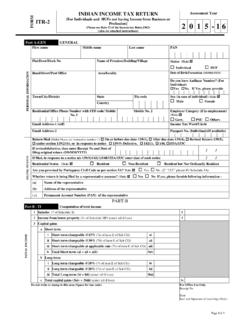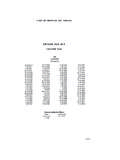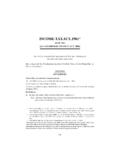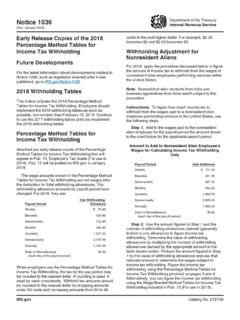Transcription of UNITED STATES - JAPAN INCOME TAX …
1 UNITED STATES - JAPAN INCOME TAX CONVENTIONA convention Between The UNITED STATES And JAPAN For The Avoidance of Double Taxation And The Prevention ofFiscal Evasion With Respect to Taxes on INCOME Was Signed at Tokyo on March 8, Was Advised by The Senate of The UNITED STATES on November 29, Was Ratified by the President of the UNITED STATES onDecember 28, 1971, And by JAPAN on June 2, Instruments of Ratification Were Exchanged at Washington onJune 9, convention Was Proclaimed by the President on July 25, 1972, and Entered into Force onJuly 9, EFFECTIVE DATE UNDER ARTICLE 28: 1 JANUARY 1973 TABLE OF ARTICLESA rticle 1---------------------------------Taxes CoveredArticle 2---------------------------------Defini tionsArticle 3---------------------------------Reside nceArticle 4---------------------------------Genera l Treaty RulesArticle 5---------------------------------Avoida nce of Double TaxationArticle 6---------------------------------Source RulesArticle 7---------------------------------Non-di scriminationArticle 8---------------------------------Busine ss ProfitsArticle 9---------------------------------Perman ent EstablishmentArticle 10-------------------------------- INCOME from Ships and AircraftArticle 11--------------------------------Associ ated EnterprisesArticle
2 12--------------------------------Divide ndsArticle 13--------------------------------Intere stArticle 14--------------------------------Royalt iesArticle 15-------------------------------- INCOME from Real PropertyArticle 16--------------------------------Capita l GainsArticle 17--------------------------------Indepe ndent Personal ServicesArticle 18--------------------------------Depend ent Personal ServicesArticle 19--------------------------------Teache rs and ResearchersArticle 20--------------------------------Studen ts and TraineesArticle 21--------------------------------Govern ment EmployeesArticle 22--------------------------------Rules Regarding Personal INCOME ArticlesArticle 23--------------------------------Privat e Pensions and AnnuitiesArticle 24--------------------------------Diplom atic and Consular OfficialsArticle 25--------------------------------Mutual Agreement ProcedureArticle 26--------------------------------Exchan ge of InformationArticle 27--------------------------------Mutual AssistanceArticle 28--------------------------------Entry into ForceArticle 29--------------------------------Termin ationNotes of Exchange I--------------------of 8 March, 1971 Notes of Exchange II-------------------of 8 March, 1971 Letter of Submittal----------------------of 26 April, 1971 Letter of Transmittal--------------------of 11 May.
3 1971 The Saving Clause -------------------Paragraph 3 of Article 4 TAX convention WITH JAPANMESSAGEFROMTHE PRESIDENT OF THE UNITED STATESTRANSMITTINGTHE convention BETWEEN THE UNITED STATES OF AMERICA AND JAPAN FOR THE AVOIDANCEOF DOUBLE TAXATION AND THE PREVENTION OF FISCAL EVASION WITH RESPECT TO TAXES ONINCOME, SIGNED AT TOKYOON MARCH 8, 1971 LETTER OF SUBMITTALDEPARTMENT OF STATE,Washington, April 26, PRESIDENT,The White House. THE PRESIDENT: I have the honor to submit to you, with a view to its transmission to the Senate for adviceand consent to ratification, a convention between the UNITED STATES of America and JAPAN for the avoidance ofdouble taxation and the prevention of fiscal evasion with respect to taxes on INCOME , signed at Tokyo on March8,1971.
4 This convention , upon entry into force, would replace the convention of April 16, 1954, relating to the avoidanceof double taxation with respect to taxes on INCOME , as modified and supplemented by protocols of May 7,1960, andAugust 14,1962 (6 UST 149; 15 UST 1538; 16 UST 697; Treaties and Other International Acts Series 3176, 5637,and 5798). On the occasion of the signing of the new convention , the American Ambassador to JAPAN . and the JapaneseMinister for Foreign Affairs also signed two exchanges of notes relating to understandings in regard to certainprovisions of the convention , as explained more fully hereinafter. The exchanges of notes are also submittedherewith with a view to their transmission, for the information of the Senate, along with the convention .
5 The new convention reflects changes in the internal tax laws of the UNITED STATES and JAPAN and takes intoaccount recent developments in treaty policy of the two countries. It follows as closely as policy and technicalconsiderations permit the model draft convention published in 1963 by the Organization for Economic Cooperationand Development which the UNITED STATES joined on September 30,1961 and JAPAN joined on April 28,1964. Except for maximum rates on investment INCOME , the substance of the new convention is similar to that ofincome tax conventions recently concluded by the UNITED STATES with France, Finland and Belgium. The newJapanese convention provides, in general, the same maximum rates on investment INCOME as in the existing (1954)( convention , , 10 percent on direct investment dividends, 15 percent on other dividends, 10 percent on interestand 10 percent on royalties (including motion picture royalties).)
6 The following changes from the existing convention represent substantive improvements: 1. The force of attraction rule would be eliminated. Under the new convention the reductions in the rate ofwithholding tax on investment INCOME would be applicable as long as the investment INCOME is not effectivelyconnected with a permanent establishment which the taxpayer has in the taxing country. Under the existingconvention the mere existence of a permanent establishment makes the reductions inapplicable. INCOME can be taxed at 10 percent under both the existing and new conventions, and both conventionsprovide an exemption for interest received by the Bank of JAPAN and the Export-Import Bank of JAPAN and theFederal Reserve Banks of the UNITED STATES and the Export-Import Bank of the UNITED STATES .
7 The new conventionextends the exemption from Japanese tax to interest received by residents of the UNITED STATES on debt obligationsguaranteed or insured or indirectly financed by those UNITED STATES banks and reciprocally extends the exemptionfrom UNITED STATES tax to interest received by residents of JAPAN on debt obligations guaranteed or insured orindirectly financed by those Japanese banks or insured by the Government of JAPAN . definition of direct investments for purposes of the 10 percent withholding rate on dividends would bechanged to reduce the stock ownership requirement from more than 50 percent of the stock to at least 10 percent ofthe voting stock. INCOME from tangible personal property not connected with a permanent establishment of the recipientwould be exempt under the new convention , whereas the existing convention applies the 10 percent royalty rate torental INCOME .
8 The exemption would not, however, apply to rent from leases of ships or aircraft by a person notengaged in the operation of ships or aircraft in international traffic. The convention contains a preamble and 29 articles. Article 1 describes the taxes to which the convention relates: in the case of the UNITED STATES , the Federal incometaxes imposed by the Internal Revenue Code; in the case of JAPAN , the INCOME tax and the corporation tax. It alsoprovides that, for the purpose of Article 7 (non-discrimination), the convention shall also apply to taxes of everykind imposed by a contracting state or a political subdivision or local authority thereof, and that, for the purpose ofArticle 26 (exchange of information), the convention shall also apply to taxes of every kind imposed by acontracting state.
9 Article 2 contains definitions of various terms found in the convention . Article 3 defines "residents". In general, the convention is applicable only to persons (including corporations)resident in either JAPAN or the UNITED STATES . Article 4 sets forth the rule that a resident of one state may be taxed by the other state only on INCOME fromsources within that other state. The article, with certain exceptions, reserves to each state the right to tax itsresidents, and, in the case of the UNITED STATES , its citizens, as if there were no convention . In addition, the articleprovides that the exemptions or reductions in rate of tax, in the state of source otherwise afforded by the convention ,shall not apply to INCOME which is taxed by the state of residence only if remitted, when the INCOME is not actuallyremitted.
10 Article 5 provides, consistent with the laws of each country, for a credit for taxes paid to the other country. Article 6 sets forth rules for determining the source of various types of INCOME . Article 7 provides for nondiscriminatory treatment by one state of the citizens of the other state resident in thefirst state, of permanent establishments maintained in the first state by residents of the other state and of corporationsof the first state owned by residents of the other state. Article 8 provides that industrial and commercial profits of a resident of one state may be taxed by the other onlyto the extent attributable to a permanent establishment in the other state. Article 9 defines a permanent establishment.
















